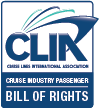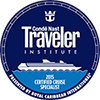SECURITY INFORMATION

The following information has been provided by the professionals at CLIA.
(Cruise Lines International Association, Inc.)
While instances of crime on cruise ships are rare, it is important that whenever traveling to be observant of one's possessions and surroundings at all times. Cruise guests are reminded of this in the daily bulletins, at port briefings and by the provision of a room safe or safety deposit box. In the event of an incident, the cruise industry takes all allegations and incidents very seriously, reports them to the proper authorities and fully cooperates in any investigation. In many instances, cruise lines do not publicly disclose detailed information in order to comply with directions given to them from law enforcement and out of respect for privacy.
Cruise ships are comparable to secure buildings with 24-hour security. All cruise ships are required to have in place formal security plans that meet national and international regulations. Every person onboard a cruise ship, from the captain to the cleaning staff and all guests, are placed on official manifests. When sailing to or from U.S. ports, these manifests are provided to U.S. federal law enforcement officials prior to the ship's departure.
Guests should be very comfortable with the security measures they see during their cruise vacation. These include the screening of 100 percent of all luggage, carry-on's and provisions coming onto our ships. Screening is done with X-ray machines, metal detectors and human and detector dog searches.
Guests and crew may embark or disembark only after passing through security. Once a ship is underway, access is strictly limited to documented employees and fare-paying guests.
Each guest is issued an identification card which contains their digital photo and personal identification information on a magnetic strip that he or she must present when entering or leaving the ship. This technology allows the ship to know which guests and crew members are onboard and which are not.
Each cruise ship has a dedicated security officer and staff whose sole function is the security of its guests and crew. Typically, security staff personnel have former law enforcement or military background and are trained according to international security regulations.
The crew of the average cruise ship includes several teams of fire and emergency personnel able to respond immediately to any emergency. An average-sized, ocean going cruise ship’s safety equipment typically includes as many as 4,000 smoke detectors and alarms.
Foreign crew members on CLIA ships are required to obtain a visa issued by the U.S. State Department for entry into the United States. This visa requires the completion of a background check. In addition, cruise ship employees are pre-screened by recruiting agencies.
Cruise lines operate within a legal framework under which international, federal and state authorities investigate crimes onboard cruise ships. Unlike most instances of shore side crime, the FBI has the authority to investigate and prosecute alleged crimes in international waters involving Americans.
The U.S. Coast Guard has jurisdiction for inspection and enforcement of international safety and security standards for all ships calling at U.S. ports. Cruise ships operating from U.S. ports are inspected regularly by the U.S. Coast Guard to ensure the vessel is following all laws pertaining to safety, security and environmental protection. Cruise ships maintain advanced communications, navigation and weather-forecasting systems.
Cruising is among the most popular vacation options in large part because of its excellent safety record and the high level of quality service cruise ships provide. The industry will continue to do its part to maintain a safe, secure and healthy shipboard environment.



